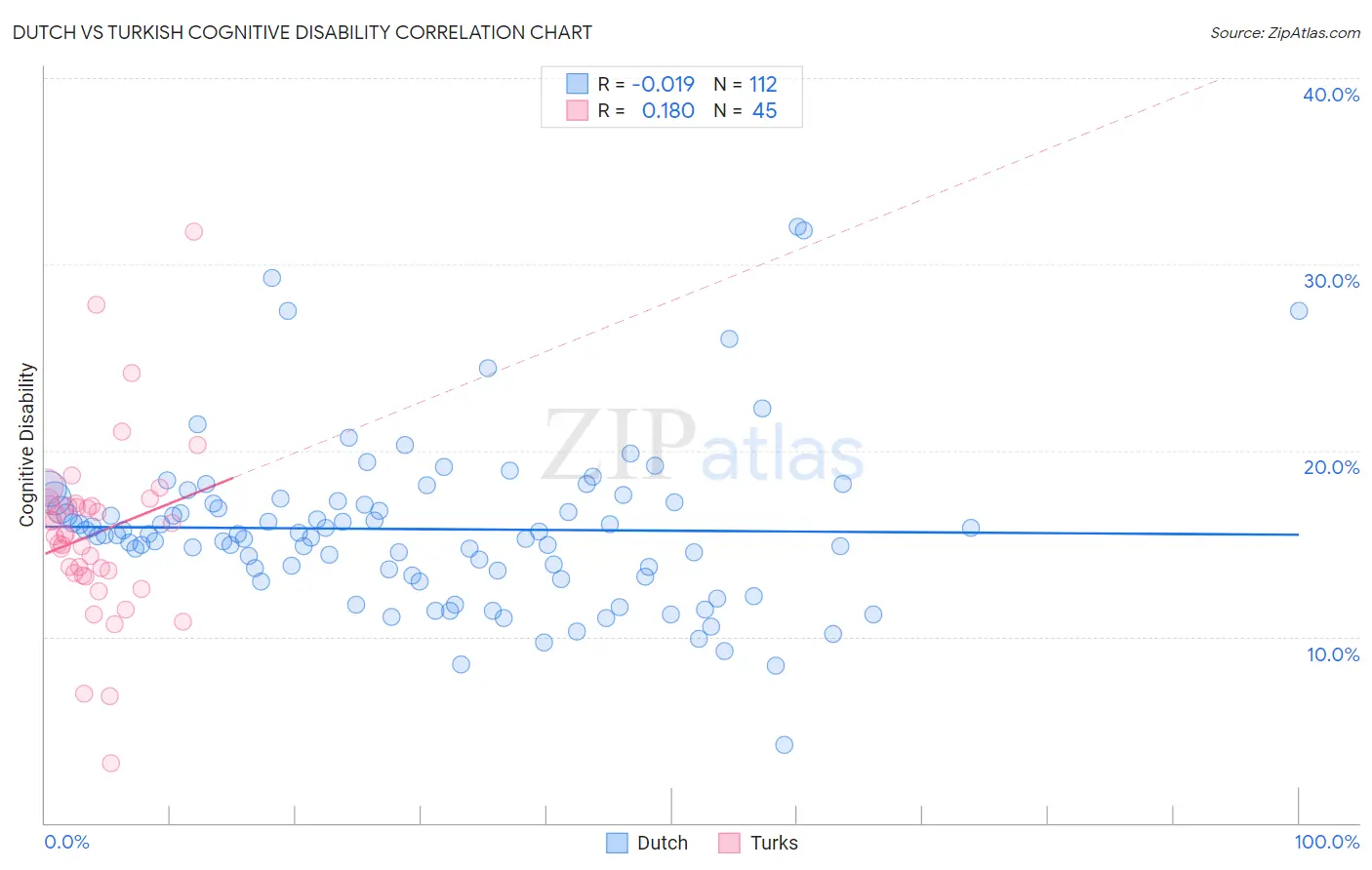Dutch vs Turkish Cognitive Disability
COMPARE
Dutch
Turkish
Cognitive Disability
Cognitive Disability Comparison
Dutch
Turks
16.8%
COGNITIVE DISABILITY
98.5/ 100
METRIC RATING
97th/ 347
METRIC RANK
16.9%
COGNITIVE DISABILITY
94.5/ 100
METRIC RATING
124th/ 347
METRIC RANK
Dutch vs Turkish Cognitive Disability Correlation Chart
The statistical analysis conducted on geographies consisting of 554,237,240 people shows no correlation between the proportion of Dutch and percentage of population with cognitive disability in the United States with a correlation coefficient (R) of -0.019 and weighted average of 16.8%. Similarly, the statistical analysis conducted on geographies consisting of 271,856,342 people shows a poor positive correlation between the proportion of Turks and percentage of population with cognitive disability in the United States with a correlation coefficient (R) of 0.180 and weighted average of 16.9%, a difference of 0.97%.

Cognitive Disability Correlation Summary
| Measurement | Dutch | Turkish |
| Minimum | 4.2% | 3.2% |
| Maximum | 32.0% | 31.8% |
| Range | 27.8% | 28.5% |
| Mean | 15.8% | 15.5% |
| Median | 15.5% | 15.5% |
| Interquartile 25% (IQ1) | 13.4% | 13.4% |
| Interquartile 75% (IQ3) | 17.2% | 17.1% |
| Interquartile Range (IQR) | 3.9% | 3.8% |
| Standard Deviation (Sample) | 4.4% | 4.8% |
| Standard Deviation (Population) | 4.4% | 4.8% |
Similar Demographics by Cognitive Disability
Demographics Similar to Dutch by Cognitive Disability
In terms of cognitive disability, the demographic groups most similar to Dutch are Finnish (16.8%, a difference of 0.010%), Immigrants from Lebanon (16.8%, a difference of 0.020%), English (16.8%, a difference of 0.040%), Asian (16.7%, a difference of 0.10%), and Jordanian (16.8%, a difference of 0.11%).
| Demographics | Rating | Rank | Cognitive Disability |
| South Americans | 98.8 /100 | #90 | Exceptional 16.7% |
| Danes | 98.8 /100 | #91 | Exceptional 16.7% |
| Immigrants | South America | 98.8 /100 | #92 | Exceptional 16.7% |
| Immigrants | Southern Europe | 98.7 /100 | #93 | Exceptional 16.7% |
| Asians | 98.7 /100 | #94 | Exceptional 16.7% |
| English | 98.6 /100 | #95 | Exceptional 16.8% |
| Finns | 98.5 /100 | #96 | Exceptional 16.8% |
| Dutch | 98.5 /100 | #97 | Exceptional 16.8% |
| Immigrants | Lebanon | 98.4 /100 | #98 | Exceptional 16.8% |
| Jordanians | 98.2 /100 | #99 | Exceptional 16.8% |
| Immigrants | Russia | 98.2 /100 | #100 | Exceptional 16.8% |
| Immigrants | Asia | 98.1 /100 | #101 | Exceptional 16.8% |
| Irish | 98.1 /100 | #102 | Exceptional 16.8% |
| Paraguayans | 98.0 /100 | #103 | Exceptional 16.8% |
| Palestinians | 98.0 /100 | #104 | Exceptional 16.8% |
Demographics Similar to Turks by Cognitive Disability
In terms of cognitive disability, the demographic groups most similar to Turks are Portuguese (16.9%, a difference of 0.020%), Immigrants from Western Europe (16.9%, a difference of 0.030%), Immigrants from China (16.9%, a difference of 0.050%), Scandinavian (16.9%, a difference of 0.050%), and Scottish (16.9%, a difference of 0.070%).
| Demographics | Rating | Rank | Cognitive Disability |
| Immigrants | Japan | 96.2 /100 | #117 | Exceptional 16.9% |
| Immigrants | Denmark | 96.2 /100 | #118 | Exceptional 16.9% |
| South Africans | 95.5 /100 | #119 | Exceptional 16.9% |
| Scottish | 95.0 /100 | #120 | Exceptional 16.9% |
| Immigrants | China | 94.9 /100 | #121 | Exceptional 16.9% |
| Immigrants | Western Europe | 94.8 /100 | #122 | Exceptional 16.9% |
| Portuguese | 94.7 /100 | #123 | Exceptional 16.9% |
| Turks | 94.5 /100 | #124 | Exceptional 16.9% |
| Scandinavians | 94.1 /100 | #125 | Exceptional 16.9% |
| Europeans | 93.4 /100 | #126 | Exceptional 17.0% |
| Immigrants | Costa Rica | 93.1 /100 | #127 | Exceptional 17.0% |
| Nicaraguans | 93.0 /100 | #128 | Exceptional 17.0% |
| Immigrants | Uruguay | 92.9 /100 | #129 | Exceptional 17.0% |
| Immigrants | Vietnam | 92.4 /100 | #130 | Exceptional 17.0% |
| Immigrants | Germany | 92.1 /100 | #131 | Exceptional 17.0% |